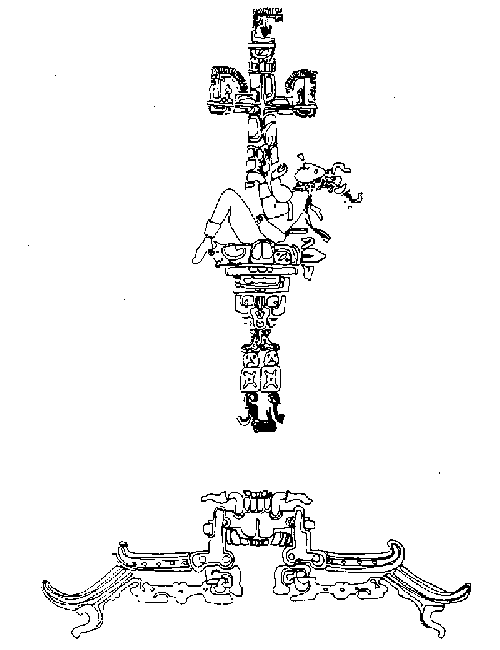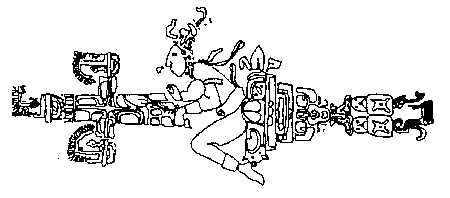Science in Ancient Artwork
PAKAL: A COMMENT
"Pakal, The Maya
Astronaut:
A Study of Ancient Space Travel"
by Charles William Johnson
Innumerable scholars have suggested that the sculpture
of Pakal represents an astronaut possibly from another part of the Universe.
One of the most popular works in this line of interpretation has come
from Erich Von Däniken (v.gr., Chariots of the Gods, 1968). Many
more interpretations have been forwarded since that time. In fact, some
students have even stated that human beings came about from genetic manipulation
by ancient space travelers. Even the ancient works such as the pyramids
of Egypt were built by people not of this earth. The theses are infinite,
as rich as the wealth of human imagination. An excellent critique of some
of the many ideas that have been suggested regarding this theme has been
written by William H. Stiebing, Jr., Ancient Astronauts, Cosmic Collisions,
1984.
Our analysis does not propose any original thesis to ponder. We simply make an analysis
of the vehicle in which Pakal is seated from the perspective of movement and simple mechanics.
We suggest that the elements of the vehicle may be rotated according to the direction implied
in the artwork itself. By doing that, the vehicle takes on a logic of its own, whereby it would
seem that the artist had conceptualized something very similar to a spacecraft. We show the
positions of lift-off and full-flight of the vehicle. The images that result are highly
suggestive of what we now know to be travel beyond our own atmosphere at least.
As far as we know, the maya did not have such a capability or technology. In fact, we have no
evidence in any ancient culture of such a capability. That particular point has always been
outstanding: if there had been space travel during ancient times, it would seem that at least
one minute part of the vehicle would have survived somewhere. A bolt, a rivet, a piece of
piping, something ever so small would surely have been found by now in all the diggings
that we have been carrying out since then. Granted that metal does not have the durability
that stone does to exterior climate, but by chance something would have been preserved
in a tomb somewhere. Granted also, we are surmising that the vehicle was made out of metal,
and not out of simple energy fields. But, since we know so little about those subjects, we can
only speculate from the perspective of simple mechanics and how metal moves along pivots
and joints.

The Pakal sculpture may represent, then, a registering of a particular visit by others coming
from a different part of the universe. Homage may have been offered in this manner of registering
it in stone. It is difficult to make any conclusive suggestion about even the possibility that the
images that we are viewing might actually represent space travel, muchless attempt to guess
how many trips were made. But, what is significant throughout ancient cultures is the fact that
events were registered in stone to last. Stone was chosen over wood; wood would evidently be
easier to carve. Their concept of time was in accordance with the medium that they chose for the
expression of their works.
Furthermore, the manner in which they sculpted the stone was characteristic
of a profound and exact scientific knowledge, resting on astronomy, mathematics,
geometry, minerology, all of which was expressed in their artwork. The
precision of translating their scientific knowledge into the artwork still
causes to wonder how they achieved such standards of performance. Hence,
the frequent need to attribute their achievements to anyone other than
to themselves. We basically believe our human ancestors to have been incapable
of having achieved the legacy that they apparently left us. At the same
time we admire their awe inspiring artwork, we call them 'primitives'
or even unfortunately 'savages'. We see no contradiction in thinking of
all or most of those who preceded us on this planet as being anything
less than human, while at the same still not being able to comprehend
their abilities.
The precision that is reflected in their artwork also reveals the nature of the knowledge that they
were attempting to communicate. They chose their medium well. The stone was surely made to last.
The format chosen was for all to see. The knowledge was guarded in secret, yet, contradictorily so,
it was sculpted in stone for all to see; not only in their generation, but for generations to come. In fact,
as we shall observe from our studies, the knowledge was registered in such a manner as to permit
learning it and knowing its intricacies. The knowledge was, in fact, not hidden; it is keyed and encoded
into the sculptures and the architecture in such a manner, with such a precision that anyone who studies
it will discover its logic. The knowledge is there for all to see. The idea may be that it is there for those who
look, those who wish to see.
This may be observed throughout the ages. The designs and patterns of the ancient knowledge have
been handed down among the descendants of the ancient cultures. They may be seen in the basketwork,
in the ceramics, the sculpture, and in the textiles even today. It is obvious that the knowledge was distributed
throughout all walks of life in almost all of the cultures. In a sense, it would appear as though the works were
designed as a teaching device, to teach everyone to 'see'. The knowledge was for everyone; it remains
there for everyone to see. That is the way the ancestors designed it through their own works, whereby it
exists even today for all to contemplate and learn from it.
In our study of the ancient sciences and artwork we are attempting to comprehend the lessons that are
being conveyed by the ancestors. One lesson that appears to be outstanding: that each particular element
may enjoy many distinct meanings. Meanings are relational; it depends upon how one relates a particular
element to others that assigns that element significance. In that sense, no particular meaning or element
has one single meaning; the meanings are infinite. Their mode of thought is relational; not relative or relativist.
Rather it is relational or in relation to all other elements. This same kind of procedure seems to have been
followed in their calendrical systems and the manner in which they counted time and whole cycles of time.
A particular number has no specific meaning, but again is relational to the system of numbers and things
being counted.
By studying in detail their calendrical systems and the scientific knowledge and artistic expression around
those systems, one can see how they developed this knowledge over time. The ancient reckoning system
works as a single system, yet appears to present distinct manners by which problems were resolved. When
this feature is examined carefully, as we are attempting to achieve in the Earth/matriX series, it should become
obvious that the ancient knowledge and artwork reflect the development of human beings on thisplanet.
By no means does it appear as though this knowledge dropped out of the skies, even if the ancient peoples
may have been visited by beings from other parts of the Universe. Such visits, if they did occur, may simply
have been that, encounters among different peoples who populate this Universe together; each learning from
the other.
In summary, it should not bother us that other beings have existed or exist in this everso immense Universe.
Nor is it difficult to see why we might think we are the only children of God after having lived here for so long
on this seemingly isolated planet in this apparently isolated solar system. Nor should it bother us that possibly
we were once or twice visited by others from this vast Universe, if they came in peace and the ancestors of
the Earth possibly saw fit to honor them in their artwork.
**********

Copyrighted © 1995-2022 by Charles William Johnson. All rights reserved. Reproduction prohibited.
"Pakal,
The Ancient Astronaut:
Paleoanimation of the Sculpture of the Maya at Palenque"
| Home | Books | Forum | Reviews | All Essays | Author |